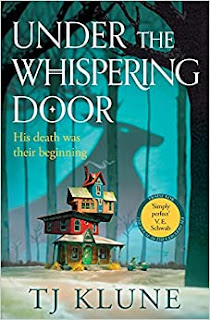UNDER THE WHISPERING DOOR (2021)
By T J Klune
Tom Doherty Associates Book, 389 pages
★★★
The House in the Cerulean Sea, TJ Klune’s previous novel, was one of my favorite novels of 2021. Under the Whispering Door also has its delights, though aspects of it suggest that he might have cranked it out a bit too hastily. In many ways, it’s the same book as Cerulean Sea, but with different characters and a different setting.
Gone are the mythological characters of Cerulean Sea, but they give way to a new cast of speculative individuals. The book’s subtitle hints at what is in store: Death is Only Their Beginning. Think a blend of Cerulean Sea, A Christmas Carol, a splash of Greek mythology, and a gay novel. It opens upon Scrooge-like attorney Wallace Price, who is powerful, ruthless, vain, and heartless. He has just fired his secretary of ten years for making the first mistake she has made in her time with the firm. Then he drops dead. In Dickens-like fashion, he observes what his colleagues think of him as he is lowered into the ground. The word that appears on most lips is “asshole.”
Luckily for Wallace there’s no rush to judgment after death. He instead finds himself in quirky house akin to that of Cerulean Sea. Note its name: Charon’s Crossing Tea, Charon being the ferryman who transports souls to Hades in Greek myth. Wallace meets Hugo who runs the tea house, but the African American Hugo is more British in his mannerisms than Charon. Wallace is furious to learn he is dead, insists it’s a mistake, and demands that he be returned to life immediately. Hugo calmly chooses a tea blend for Wallace and bids him to drink. No questions will be answered until Wallace gets a grip on himself. Besides, who wouldn’t like a nice cuppa before shuffling off this mortal coil?
Wallace discovers that the tea house is the portal to the afterlife that the dead enter via a panel in the ceiling on the 4th floor when they are ready. He will meet an unusual group that includes Hugo’s grandson Nelson, who looks older than Hugo because Nelson lived to a ripe old age. There is also Mei, the Reaper who brings Wallace to the tea house and is still new to her job. There’s also wordless Nancy who lost a child; Alan, a murder victim; and Desdemona, who comes to the tea house to hold seances.
One of the tea house’s many quirks is that it’s a hangout for both the dead and the living. Hugo is among the latter, though his dog Apollo is a ghost like Wallace and the living patrons can’t see or hear ghosts. Wallace wonders if this means that Hugo is God, but is assured that he’s only the ferryman. There are vague references to The Manager, who must not get involved in any passing to the next realm if everyone knows what’s good for them. Wallace is literally hooked by a long line to Hugo. He remains intent on fleeing back to the land of living, until he encounters Cameron, who tried that and became a hollowed-out zombie destined to wander in mindless limbo for all eternity.
Wallace masters sitting down and how to eat some of Hugo’s delicious baked goods, but he has a lot to learn and not much time to absorb it. In another nod to A Christmas Carol, Wallace is forced to consider why he was an asshole and he wishes to redeem himself. He will also fall in love with Hugo. Talk about a relationship with no future!
Under the Whispering Door has been called a “gay love story” and a “fairy tale for adults.” Both labels are apt. There is a sweetness to Klune’s writing and doses of humor that make him a joyful read. Still, it’s very much a derivative work and its deux ex machina resolution is way too pat. Whereas Cerulean Sea felt wildly inventive and offbeat, this one induced feelings akin to when I watch a sequel of a great movie that’s not bad, but not a patch on the original. I hope that Klune takes his time with his next novel and takes us somewhere new rather than simply changing his vest and returning us to the same party.
Rob Weir






